Well, I suppose I should say something about One for All…
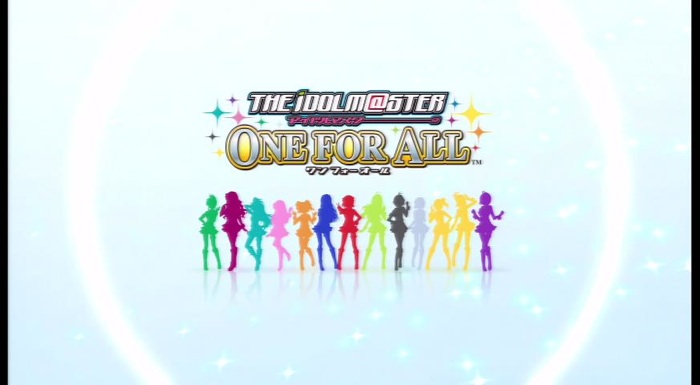
I suppose it’s probably long past the point where me actually saying something about One for All is productive or useful to anyone. It’s not really through a lack of playing it, mind you, more a combination of laziness and bad timing. Whilst I’d well prepared for the games launch back in May, booking time off work to play it, I ultimately decided that it’d be far more productive to spend that time on a last minute trip to Chicago to ogle real-life idols instead of cartoon ones. Missing that launch window really threw off my timing, though.
Still, though, four months, a Platinum trophy and the best part of eighty hours of play time later, I guess I should write at least something about it.
I rather feel that merely the moniker sets up some expectations about the game in itself. Not numbering the game “iDOLM@STER 3” conjures up images of something largely recycling materials from the previous main series entry. The name One for All continues to make me wonder if the game was originally started with the intention of making an iM@S free-to-play game, in line with what Namco have done relatively with their other major franchises like Ace Combat, Tekken and Soul Calibur. Whilst there’s nothing like recharging energy bars to gate gameplay, there’s things about the game progression that wouldn’t be alien to such a product.
I’m getting ahead of myself, though. One for All is the latest production-type iM@S game, but it eschews a lot of the format of previous iM@S home games. Gone is the fixed period, year-long, specific-goal game structure, replaced with a rather more open-ended, free form game. The game divides itself into an unending series of twelve-week seasons, each with a seasonal-goal associated with it – the game will ask you, for example, to complete a certain number of Festivals, earn a certain amount of money or gain a given number of fans. Complete this and you’ll gain a Producer Rank and a cash prize. Fail and… I’m not actually sure, because they’ve all been rather easy.
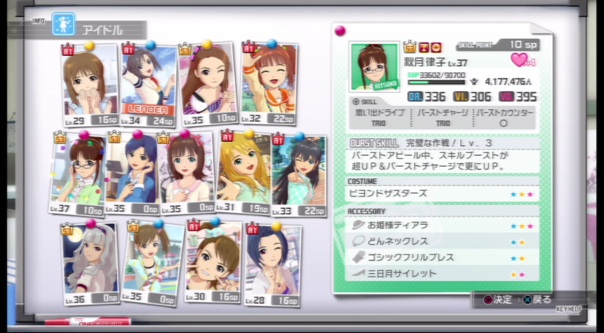
You unlock everyone eventually, but it does take quite a while to get there…
Gone as well is the fixed idol unit. The game starts with the boss asking you to pick one idol and one song out of the selection presented to you to produce, and as you successfully progress through the seasons, you will periodically be given the choice of additional idols (and songs) to produce, until you get to the point where you are managing all of the 765Pro AllStars. The game allows you to switch your attention to any idol under your wing as you see fit.
Still, to counter having more girls to juggle at once, there is a significant simplification to the production part of things. There’s no more worrying about your idols moods, or having to be concerned about their Danketsu because you’re focusing too much on other girls. There’s no worrying about maintaining popularity across specific regions of Japan, either.
What actually constitutes a “turn”, or a week of game time, is a little different to previous games. Lessons are still in, but whilst the game only allows you to perform one a week, it doesn’t actually move the clock forward. The main talking-type events have been removed from being time-consuming Promotional weekly actions for the most part as well, leaving just a single free and paid promotion per rank per idol. This basically just leaves the performance-type events as the main progression mechanism, and you’ll be seeing an awful lot of them.
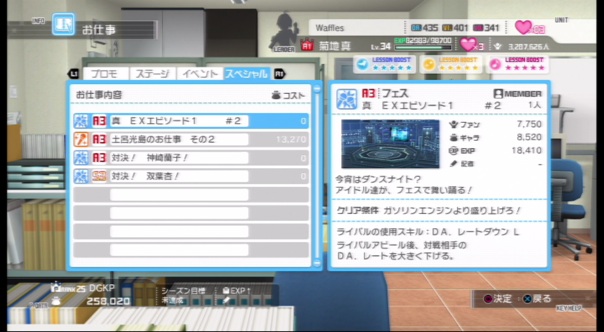
Whilst there’s four categories of “work”, everything other than “promo” is a performance, and there’s only ever two promo’s.
As with iM@S2, the performances basically boil down into permutations of three categories – lives, auditions and Festivals. Lives challenge you to meet a certain score, whilst auditions require you to score well enough to outdo some vague unseen concept of other idol units to place well enough to pass – they’ve always been kind of vague, but the main difference in practice is that they throw time-limited multipliers into the mix. Festivals are the rather stickier wicket, where you are challenged to beat the score of another specific idol unit, performing simultaneously, who can interfere in a fashion with your gameplay.
The actual play mechanics of performing are, on the surface, unchanged from iM@S2 – you still have the three circular Appeal gauges, with a pulsating timing indicator synced to the songs BPM. Successively timing an appeal with score you points in line with your units current stat in the relevant area (Dance, Visual and Vocal, as always), modified by a multiplier rate. At the same time, to dissuade you to have unbalanced stats, performing an appeal will reduce the multiplier rate for that appeal type as it simultaneously increases another. Also back are Memories appeals, a limited resource which scores in and boosts rates in all appeal areas.
The Voltage gauge is back from iM@S2 as well. The Voltage gauge fills in small increments – or large ones for Memories appeals – as you successfully appeal. Once it fills up, you can perform a Burst appeal, which temporarily massively increases your appeal multipliers for massive scores. The difference in OfA, compared to iM@S2, is that the removal of Danketsu means the score for each appeal during a Burst is based on your standard appeal category statistics. The long-game in iM@S2 generally revolved around throwing all your lesson, costume and song choices into boosting your Vocal and Image stats so that you could Burst with Hibiki – Hibiki had a really lopsided burst ratio (by which I mean the number of each type of appeal in her burst), matched only by Chihaya’s in the 360 version (it was nerfed in the move to PS3), so having a big Dance multiplier for the Danketsi-effected burst appeals was the key to really high scores. It rendered you Dance skills meaningless, as you would never use that appeal outside of Bursts.
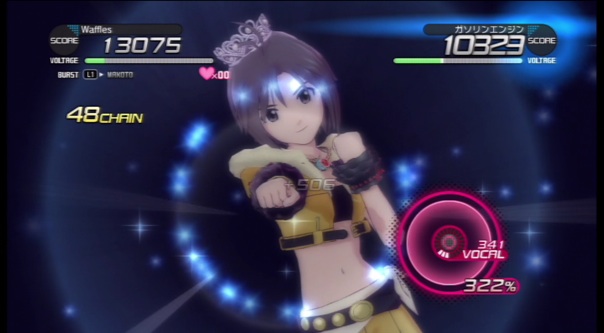
That Crown was really freaking expensive… in game-money terms, thankfully.
As you begin the game, the performance events aren’t actually all that interesting – boring, almost. There’s not too much going on with them. Festivals are a little more interesting, because they’re all about the management of the Voltage gauge – your opponent has a Voltage gauge too, and performing memories and burst appeals effects both your own gauge positively, and your opponents negatively. There’s a certain strategy to timing your memory appeal usage to prevent your opponent from Bursting, thus keeping their score under control. It takes a very different style of play to the other performance types, where boosting your own score is almost secondary to kneecapping your opponents.
Where things get really interesting, though, is later into the game as the changes to idol progression system made for OfA really start to come into play. Lessons in One for All are actually only temporary effects, lasting but a few weeks of game time. In place of lessons, the progression of your idols in done with a level system – completing events and performances earn your idols experience, and when they gain enough to level up (or you complete a Rank Up event), you get points to spend on a RPG-style skill tree for that idol, improving attributes beyond the natural level-up gain. Skills unlocked on the skill tree start as simple as just improving your base Appeal stats, but also include things which have an effect on the way your character Bursts. There’s Burst Counters, for example, where if you manage to fill your gauge as your opponent is bursting, you can activate your own, cutting theirs short whilst dealing them a massive penalty to their appeal rates. There’s also Burst Charge, which allows you to expend memories on a Burst-ready Voltage gauge whilst performing in a multi-idol unit, creating a two or three idol super-charged Burst.
The big thing, however, is that all the idols have unique Burst effects you can unlock and level. These are effects which apply either when you Burst, or when you successfully combo all the Appeals in a Burst. These range in effect all over the place, from instantly filling a significant portion of your Burst gauge back up, to increasing the upper ceiling on your appeal rate multiplier, to simply coming out of the Burst appeal with a big increase in one or more of your multiplier rates.
It’s here where the meta-game gets interesting, as idol selection and burst timing can become paramount, particularly in festivals. Bursting successfully with Takane will automatically give you a not-insignificant part of your gauge back, effectively assisting in you being able to repeatedly block an opponent from bursting, but if you burst with Yayoi you’d get a really useful boost in all your multipliers. You could use a memory appeal to Charge your burst and apply both effects, but could that memory be more useful going towards another Burst? More importantly, it causes a delay which may allow your opponent to Burst first, knocking you off the Burst point and effectively wasting any memories used to get there.
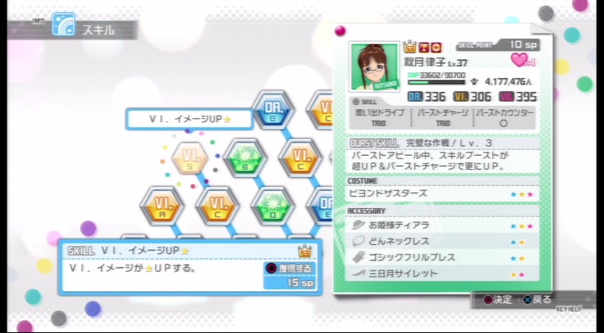
I call it a “tree”, but it’s not like you are making permanent branching choices…
I should probably point out that, particularly in later Festivals, your opponents have Burst skills as well, and some of them are really nasty. The score boost they get from it is bad enough, but when you find yourself losing a significant chunk of your gauge at every appeal point, preventing a counter even if you burn through your memories, it’s rather disheartening. Using your Memories to diminish your opponents gauge, or to rush to a Burst Counter, becomes increasingly imperative.
Winning Festivals is pretty important to your continued progression through the game, too. Whilst you have a skill tree with abilities to unlock, most of the blocks are gated by your Idol Rank. the idol rank is a grading from E3 all the way up to A1 (in the initial game, anyway). To progress to the next idol rank, unlocking the next set of skills, you have to progress through the three points of the letter grade until the next category by completing Rank Up Festivals (although once one idol paves the way, the others can skip the subgrades and try to jump a whole letter at once, given they have enough fans to participate).
Rank Up Festivals are particularly tough events – they are ultimately best-of-three events against especially tough opponents with really nasty Burst skills. You need to change songs between rounds, and you are given the opportunity to change your back-up idols – by switching the other members of a trio, you can refresh your stock of memories. It becomes a series of tactical choices – do you put everything into the early songs in the hopes of matching your opponent, or do you save those idols with higher levels, more memories and better skills to the later rounds, so you can steamroll your opponent when they have fewer memories remaining themselves?
Every couple of seasons, you’ll also get the chance to perform an All-Star Live. Even if you aren’t producing them all yet, you’ll be asked to split all the 765Pro All-Stars into three units, performing three songs in an attempt to reach an accumulative score high enough to pass. Complete it successfully, and you’ll get to see a special performance video – a nice, high-quality prerendered video featuring all of 765Pro on stage at once, usually resulting in something else nice being unlocked at the end.
The accumulation of Memories works somewhat differently from the other iM@S games as well. Rather than being the consumable reward for performing character interaction events, it’s a permanent resource for each idol, refilled every week. You still have to grind things out somewhat – each idol starts with a maximum of but one memory appeal a piece, but by successfully completing any event with that idol, be it discussion or performance, the gauge to increase the number you get for her will slowly fill up until you have another added. I’m not sure if there’s a maximum, but it’ll be at least five if there is, and that fifth takes so long to gain it may as well not be there.
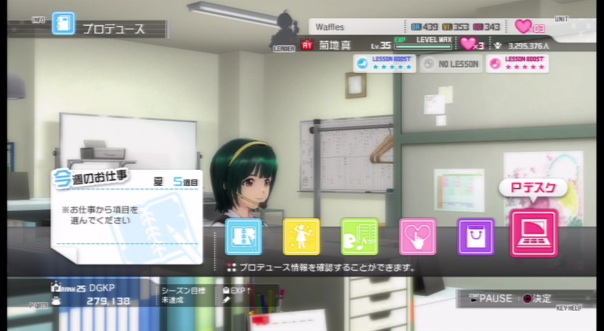
KOTORI!!!!!!!
The overall presentation of the game rather impresses compared to some of the earlier iM@S games. Each week of the game generally begins with the producer walking into a fully-rendered 765Pro office, where various idols will be floating around, interacting or welcoming the Producer into the office. The production menu will typically be accompanied by the sight of Yayoi cleaning the windows, Haruka falling over, or Kotori, rendered in 3D for the first time, getting on with her work. The office will undergo seasonal changes, too, be it redecorated in Halloween iconography, or the whiteboard covered in birthday wellwishes at the appropriate time of year.
With the promotional events section of your weekly actions seriously curtailed, they also added what amounts to a skits section to the production menu. Periodically, typically when you unlock a new idol or when they rank up, new scenes will appear for viewing in this menu, up to one for each idol at a time. You can watch these without consuming a week of game time, so you can play them all in one go.
The nice thing is that the change from managing a fixed group of three idols to managing everyone has made a big difference in the types of scene they could do. In previous iM@S games, the number of permutations you could have when selecting a group of three idols resulted in scenes being pared down to featuring just the producer and a single girl, or at best the addition of a Ryugu member in iM@S2. Here they could guarantee the availability of everyone at some point in the game, so whilst the scenes are categorised by girl, they often feature multiple characters. It’s nice, because it gives the game much more of the feeling of the anime, where everyone is kind of just hanging around between work.
There’s a few types of random spot event as well – sometimes an idol might call out to you whilst walking to the office, leaving you to guess who it is just from the voice (as per usual, Shimoda Asami throws a bit of a curveball at times – her mimicry skills are too strong). Sometimes you are asked to buy an idol a drink from a vending machine, leaving you pondering if Takane would prefer Green Tea or that can of coffee.
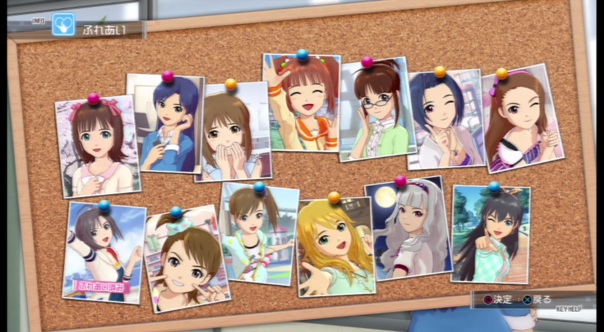
I say “skits” in a Tales sense, but it’s actually “ãµã‚Œã‚ã„”, or “Contact”, I guess…
That being said, this is where the game falls down a bit as well. As nice as all the skit scenes are, the game somehow manages to feel a little thin in terms narrative push. Whilst they throw out Jupiter in favour of a new rival character, the towering Leon (voiced by veteran voice actress Chihara Minori), she’s used frustratingly sparingly throughout the main game. Whilst there’s occasionally things going on, there’s not quite enough to make the game not feel a little too grindy at times.
Of course, Namco, perhaps living up to their Scamco moniker, have you covered if you are will to pay for it. They’ve started rolling out extended scenarios for purchase, extending the end-game that most iM@S devotees will have reached a while back. The first was a multi-part event, as all of 765Pro went off to perform at an event, split into four chapters as the girls perform in subgroups before reuniting at the end, featuring a healthy chunk of set-up chatter prior to their performances.
More recently, though, they’ve started rolling out individual character scenarios. Purchased either in batches of four (or five) characters at around 1700yen, or 4700yen if you want all of them, these add the first four chapters of ongoing individual stories for each of the characters, as they compete with Leon, wonder what kind of song is suitable for them, and generally ponder their place in the idol world.
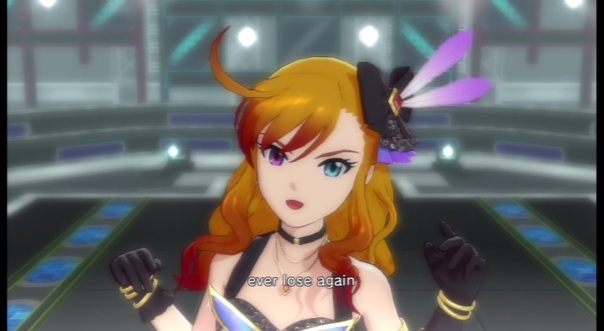
Leon is in the Takane ball-park, height-wise, if not a bit taller. She makes Ritsuko look tiny, at the very least.
Whilst 4700yen isn’t exactly what one would call “cheap”, these packs are worryingly good value by the usual iM@S standards, particularly when you consider simply adding Anzu’s performance to your Stage for You will set you back 1200yen – aside from also unlocking the progression to S-rank, upping the level cap and adding a new skill-tree tier for your idol, these first character story packs you get a new (and I mean new) solo song for each idol thrown in. These are all pretty good, too!
That said, getting to the end of the fourth chapter will present you with a To Be Continued screen – Namco are looking to get you on lock for buying yet more content, and given the generally extremely positive reaction to the writing in the character scenarios, they’ll probably continue to get a bunch of money out of a bunch of folks (myself, likely, included. Part of the problem, I guess)
All that said, more than the lack of a strong narrative arc through the main game, I honestly kind of miss the pressure of the fixed timeline during the main game. Maybe it’s just because I’m one of those weirdos who likes the stress of the deadlines even in games like the Atelier series, but the lack of a specific goal, or rather the lack of any constraints on how you go about reaching whatever goals you set yourself, leaves much of what you are going in the game feeling a little without significance.
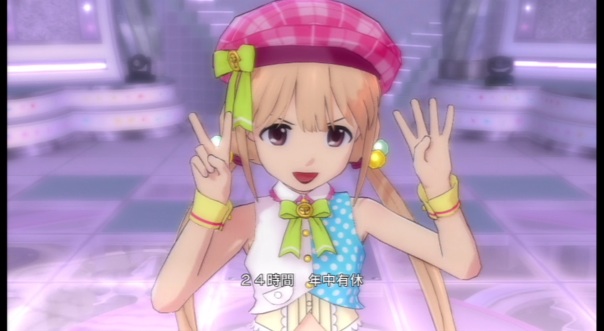
In less value-tastic DLC, they’re pretty aggressively raiding the Cinderella Girls and Million Live CD releases for songs for DLC performances.
There are probably other things I could talk about, but I’ve gone on for more than a bit already. If I was to conclude, I’d say that I really like the game in aggregate, but there’s a bunch of caveats. It takes a good while to get going, as the gameplay doesn’t really thicken out until you start to unlock more idols and their Burst skills, and the festivals start to make you scratch your head a little more, whilst the narrative pull isn’t necessarily there to drag you onwards unless you are really into this whole iM@S thing. In addition, whilst there’s no real need to buy more costumes or songs (though I really like Kimi*Channel, and there’s a really hot mermaid costume…), you kind of have to be willing to spend more on buying the DLC scenarios to get the most from the game.
On the plus side, though – rejoice, there’s no geography tests in this one!

2014-09-23
#
Wow a comprehensive review of the game. Good job. I think you didn’t talk about duo/trio bursts but otherwise p. much everything? Unless we go into the gritty like Gold multipler on songs or item effects.
By the way how far are you? I’m guessing really far.
2014-09-23
#
Yeah, I wanted to try and keep south of three thousand words www
As for how far I am, about half-way through the DLC character packs, I guess – I was doing the second event of Makoto’s story when I was taking screengrabs, and I’m pretty sure I’ve fully cleared at least Ritsuko, Mami, Takane, Chihaya and Haruka. Maybe Iori, though I might just have done her S-rank audition. Kind of taken a couple of weeks off to play Destiny and Hyrule Warriors, though!
2014-09-24
#
Leon intrigues me a lot. But that monstrous scimitar-like ahoge was quite unexpected.
2014-10-23
#
I understand that now you have to be careful about 2D girls clad in school uniforms… or HM Scotland Yard will be on you…